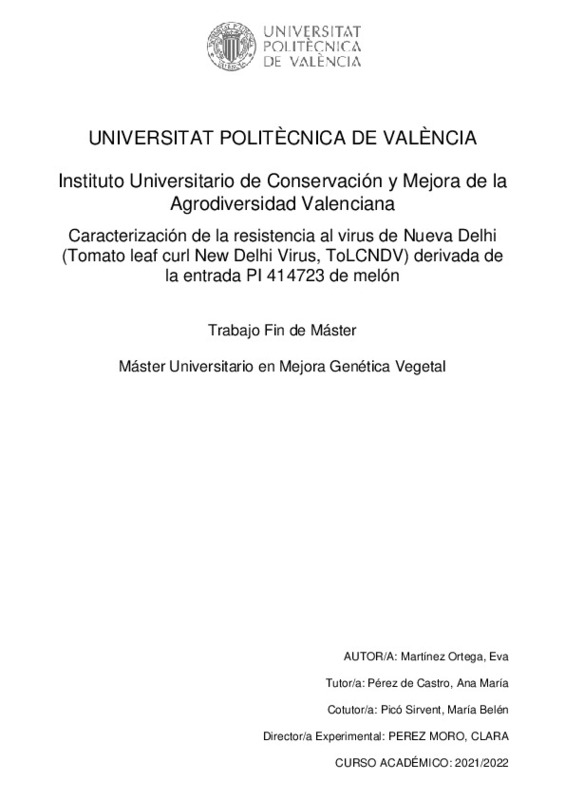|
Resumen:
|
[ES] El melón (Cucumis melo) pertenece a la familia de las Cucurbitáceas y tiene una gran importancia económica a nivel mundial. España es la novena potencia en cuanto a pro- ducción y exportaciones de melón. Aun así, ...[+]
[ES] El melón (Cucumis melo) pertenece a la familia de las Cucurbitáceas y tiene una gran importancia económica a nivel mundial. España es la novena potencia en cuanto a pro- ducción y exportaciones de melón. Aun así, anualmente se producen pérdidas provocadas por estreses abióticos y bióticos y esto conlleva la reducción de la producción y rendimiento. Entre los principales factores que amenazan su cultivo y producción a nivel mundial destacan las enfermedades causadas por virus. El virus de Nueva Delhi (Tomato leaf curl New Delhi Virus, ToLCNDV) afecta a la familia tanto de las Solanáceas como las Cucurbitáceas y entre esta última al melón. Entre las estrategias más efectivas de control de la enfermedad se encuentra la identificación e introgresión de genes de resistencia. La accesión de melón PI 414723, procedente de la India, presenta resistencia a ToLCNDV entre otros patógenos. En este trabajo (enmarcado en los proyectos de investigación PID2020-116055RB-C21 y PROMETEO/2021/072) se fenotiparon por resistencia a ToLCNDV generaciones segregantes desarrolladas a partir del cruce entre PI 414723 y un parental susceptible del tipo `Piel de Sapo ́ (11PS) y otro tipo blanco (26BL). Tras inocular mecánicamente el virus, el seguimiento de la enfermedad se llevó a cabo mediante la evaluación visual de síntomas y tissue printing seguido de hibridación molecular para determinar la presencia de DNA viral. La cuantificación de la carga viral se realizó mediante PCR cuantitativa. Además, las plantas se genotiparon empelando un marcador descrito como ligado a la resistencia a ToLCNDV derivada de otras fuentes. Los resulta- dos obtenidos en cuanto a la segregación de las generaciones parecían indicar que el control de la resistencia es poligénico. El marcador 13bis previamente identificado aso- ciado a la resistencia en WM-7, parece estar asociado a la resistencia frente a ToLCNDV derivada de la accesión PI414723. El hecho de que la entrada PI414723 presente resistencia frente a distintas enfermedades víricas (CABYV, WMV, ZYMV y PRSV) y a oídio, junto con ToLCNDV, hace que su utilización en programas de mejora sea de gran interés, ya que facilitará la obtención de variedades de melón con resistencia a los distintos patógenos.
[-]
[EN] Melon (Cucumis melo) belongs to the Cucurbitaceae family and is of great economic im-
portance worldwide. Spain is the ninth- largest producer and exporter of melons. Even
so, there are annual losses caused by abiotic ...[+]
[EN] Melon (Cucumis melo) belongs to the Cucurbitaceae family and is of great economic im-
portance worldwide. Spain is the ninth- largest producer and exporter of melons. Even
so, there are annual losses caused by abiotic and biotic stresses and this leads to a re-
duction in production and yield. Among the main factors threatening melon cultivation
and production worldwide are virus diseases. The Tomato leaf curl New Delhi Virus
(ToLCNDV) affects both the Solanaceae and Cucurbitaceae families, including melons.
Among the most effective disease control strategies is the identification and introgres-
sion of resistance genes. Melon accession PI 414723 from India shows resistance to
ToLCNDV among other pathogens. In this work (within the framework of research pro-
jects PID2020-116055RB-C21 and PROMETEO/2021/072), segregating generations de-
veloped from the cross between PI 414723 and a susceptible parental of the 'Piel de
Sapo' type (11PS) and another white type (26BL) were phenotyped for resistance to
ToLCNDV. After mechanical inoculation of the virus, monitoring of the disease was car-
ried out by visual assessment of symptoms and tissue printing followed by molecular
hybridization to determine the presence of viral DNA. Quantification of viral load was
performed by quantitative PCR. In addition, plants were genotyped using a marker de-
scribed as linked to ToLCNDV resistance derived from other sources. The results ob-
tained in terms of segregation of generations seemed to indicate that the control of
resistance is polygenic. The 13bis marker previously identified as being associated with
resistance in WM-7 appears to be associated with resistance to ToLCNDV derived from
accession PI414723. The fact that the PI414723 accession shows resistance to different
virus diseases (CABYV, WMV, ZYMV y PRSV) and powdery mildew, together with
ToLCNDV, makes its use in breeding programs of great interest, as it will facilitate the
breeding of melon varieties with resistance to the different pathogens.
[-]
|







